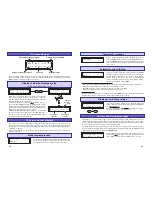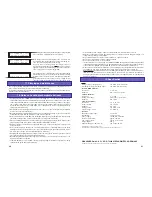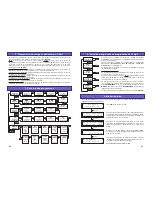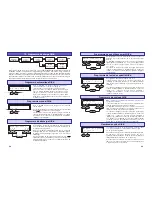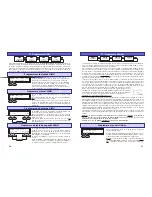
31
30
These programs are only suitable for charging and discharging Lithium-Ion batteries with a voltage of 3.6
V/cell and Lithium-Polymer batteries with a voltage of 3.7 V/cell.
The outstanding feature of Lithium batteries is their much higher capacity compared to other battery types.
However, this important advantage is offset by the need to adopt different handling strategies; they must
be charged and discharged using specific methods, otherwise they will be damaged, and can be dangerous.
The directions in these instructions must be observed at all times when handling these batteries. Specific
information and safety notes will also be found in the battery manufacturer’s technical information. The
fundamental rule is that Lithium-based batteries can ONLY be charged using special chargers, and the
charge program must be set up correctly in terms of final charge voltage capacity (charge rate) for the
battery type in use.
The charge process is fundamentally different to that required for NiCd or NiMH batteries, and is termed a
constant current / constant voltage method. The charge current required varies according to the battery
capacity, and is set automatically by the charger. Lithium batteries are usually charged at the 1 C rate (1
C charge rate = half capacity as charge current. Example: battery capacity 1500
mAh: 1 C charge current = 1500 mA = 1.5 A). For this reason it is essential to set the
battery capacity on the charger instead of the charge current. When the battery on
charge reaches the specific final voltage which is appropriate to the battery type,
the charger automatically reduces the charge current in order to prevent the battery
exceeding the final permissible voltage.
If the battery manufacturer states a charge current lower than the 1 C rate, then the
capacity-charge current must be reduced proportionally.
Problems caused by mistreating batteries:
It is very dangerous to overcharge Lithium-Ion batteries, as they tend to react by gassing, overheating and
even exploding. If the final charge voltage of 4.1 V/cell (Lithium-Ion) or 4.2 V/cell (Lithium-Polymer) is
exceeded by more than 1%, the lithium ions in the cell start to change into metallic lithium. However, this
material reacts very violently with the water in the electrolyte, and this can result in the cell exploding. On
the other hand it is also important to avoid terminating the charge process before the final charge voltage
is reached, since this reduces the effective capacity of the Lithium-Ion cell markedly. Stopping the charge
at just 0.1 V under the threshold means a capacity loss of around 7%. Lithium batteries must not be deep-
discharged, as this leads to a rapid loss of capacity. This effect is irreversible; it is absolutely vital to avoid
discharging the batteries to below 2.5 V/cell.
Caution: the cell type, cell capacity and cell count set on the charger must always be correct for the
battery to be charged; if you make a mistake, the battery could explode! Never connect a Lithium-
based battery to the charger if it features an integral charge circuit!
Lithium batteries should only be charged on a non-flammable surface.
charge time
current
voltage
MODE
MODE
MODE
MODE
Lithium
MANUAL-
program
Lithium
discharge
program
Lithium
capacity test-
program
Lithium
type-
select
12. Lithium programs
This program charges the battery using the capacity-charge
current which you set.
Before you initiate the actual program you must first set the
correct battery type, i.e. correct for the battery to be charged,
using the LiIo setup program. Check the number of cells and
adjust the setting on the charger if necessary!
Before
connecting the pack, set the battery capacity (and thus
the maximum charge current) using the INC / DEC buttons. The
charger uses this information to calculate the 1 C charge current.
Lithium manual program
_ _ _ _ _ _ _ _ _ _ _ _ _ _ _ _
_ _ _ _ _ _ _ _ _ _ _ _ _ _ _ _
L i P o
m a n u a l
C : 2 5 0 0 m A h
DEC
INC
+
-
11. NIMH programs
NiMH manual program
NiMH discharge program
_ _ _ _ _ _ _ _ _ _ _ _ _ _ _ _
_ _ _ _ _ _ _ _ _ _ _ _ _ _ _ _
N i M H
d i s c h a r g e
2 . 5 A
4 . 8 V
DEC
INC
+
-
DEC
INC
+
-
ENTER
_ _ _ _ _ _ _ _ _ _ _ _ _ _ _ _
_ _ _ _ _ _ _ _ _ _ _ _ _ _ _ _
N i M H
m a n u a l
C : 2 . 5 A
DEC
INC
+
-
This program is selected when you simply wish to recharge a batte-
ry using the set charge current.
You can adjust the charge current using the INC / DEC buttons, but
only
before
you connect the pack for charging.
The charge process is terminated automatically, in accordance with
the values entered in the user settings for “NiMH - Delta Peak -
termination voltage”, “Charge termination delay” and “Safety timer”.
NiMH capacity test program
A set of convenient charge programs for recharging
Ni
ckel-
M
etal-
H
ydride batteries. When the charge /
discharge program is finished, the screen displays the name of the charge program alternating with the
message “completed”, together with the charge time, the last (dis-) charge current, the charged-in (dischar-
ged) capacity and the battery voltage, and continues to do so until you disconnect the battery. This
information can often give you a useful indication about the NiMH pack’s charge characteristics and
capacity, or warn you if the charger has incorrectly assessed the pack as being “full”.
The typical purpose of this program is to determine the residual
capacity of a receiver or drive battery, or to discharge the pack to a
defined level.
In this program the charger discharges the pack using the set
discharge current (0.1 ... 3.0 A or automatic, left of screen) until its
voltage falls to the set final discharge voltage (0.5 ... 37.0 V or
automatic, right of screen). The set final discharge voltage should
be a value of around 0.5 ... 0.9 V
per
cell, in order to avoid the pack
becoming deep-discharged.
_ _ _ _ _ _ _ _ _ _ _ _ _ _ _ _
_ _ _ _ _ _ _ _ _ _ _ _ _ _ _ _
N i M H
c a p a c i t y
C : 2 . 5 A
D : 2 . 5 A
DEC
INC
+
-
DEC
INC
+
-
ENTER
The purpose of this program is to determine the capacity of a
battery.
The program first charges the battery using the set charge current
stated on the left of the screen (0.1 ... 5.0 A or automatic), and
then discharges it again using the set discharge current stated on
the right of the screen (0.1 … 3.0 A or automatic).
At the end of the process the screen displays the battery’s capa-
city. The
charge
process is terminated automatically, in accordan-
ce with the values entered in the user settings for “NiMH - Delta
Peak - termination voltage”, “Charge termination delay” and “Safe-
ty timer”. The safety timer is only active during the charge phase.
NiMH automatic program
_ _ _ _ _ _ _ _ _ _ _ _ _ _ _ _
_ _ _ _ _ _ _ _ _ _ _ _ _ _ _ _
N i M H
a u t o m a t i c
C : 2 . 5 A
l i m i t e d
DEC
INC
+
-
MODE
MODE
MODE
NiMH
AUTOMATIC-
program
NiMH
MANUAL-
program
NiMH
discharge
program
MODE
NiMH
capacity test-
program
In this program the charger detects the types of battery
connected and adjusts the charge current accordingly, to avoid
overcharging the pack.
The maximum charge current can be set using the INC / DEC
buttons
before
you connect the battery to be charged.
The charge process is terminated according to the values set
by the user for „NiCd Delta-Peak Termination Voltage“, „Charge
Termination Delay“ and „Safety Timer“.



















